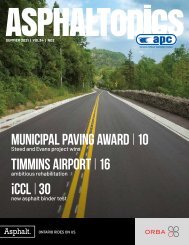ASPHALTopics | Fall 2020 | VOL 33 | NO 3
You also want an ePaper? Increase the reach of your titles
YUMPU automatically turns print PDFs into web optimized ePapers that Google loves.
WHY NB HAS ADOPTED WMA<br />
There are compelling reasons driving<br />
New Brunswick’s decision to use WMA<br />
for all of its provincial paving jobs<br />
including WMA’s reduced impact on<br />
the environment. Compared to HMA,<br />
producing WMA requires less energy,<br />
generates less heat, and produces<br />
fewer emissions. “WMA is a greener<br />
choice all around, one that is better<br />
for the planet and the people who<br />
work with asphalt in the plant and<br />
on the roads,” Sweezie says.<br />
“As well, the lower heat levels used<br />
to produce WMA mean that you’re not<br />
oxidizing the binders during production,”<br />
he adds. “The result is an asphalt<br />
mix that retains more of its intended<br />
qualities and lasts longer in usage<br />
because the binders have not been<br />
overheated.” In the DTI’s experience,<br />
the durability of WMA doesn’t just<br />
match HMA’s performance on the<br />
province’s roadways; it exceeds it.<br />
In addition, WMA remains workable for<br />
a longer period of time than HMA does<br />
at the work site. “Because WMA is a<br />
lower temperature mix in comparison<br />
to HMA, it doesn’t lose heat as fast<br />
because the difference between its<br />
heat and that of the ambient air isn’t<br />
as large,” says Sweezie. This gives the<br />
province’s paving crews more leeway<br />
to work with the WMA product without<br />
compromising its quality. It also extends<br />
the number of weeks that the DTI pave<br />
in New Brunswick each year.<br />
Compaction is another area where<br />
WMA performs well for New Brunswick.<br />
The DTI has compiled research that<br />
shows that WMA provides better<br />
compaction than HMA as well as<br />
delivering a more consistent product<br />
overall. “If you take the same aggregate<br />
mix, the same road project, the same<br />
time of year, the same crew and the<br />
same equipment, you will see better<br />
compaction results when you use WMA<br />
compared to HMA,” Sweezie says.<br />
In the DTI’s experience, WMA doesn’t just match<br />
HMA’s performance on the province’s roadways;<br />
it exceeds it.<br />
“We are also seeing superior<br />
performance and durability in<br />
longitudinal joints formed with WMA<br />
compared to HMA,” he continues. “What<br />
we are not seeing is inferior roadway<br />
lifespans using WMA versus HMA. WMA<br />
does everything that HMA does, and adds<br />
the benefits I’ve mentioned as well.”<br />
Finally, using WMA results in less heatrelated<br />
damage to asphalt production<br />
plants, transport vehicles, and paving<br />
equipment. The lower temperature is<br />
also what reduces emissions.<br />
Overall, WMA has proven itself to<br />
be a worthy — even superior — paving<br />
product on New Brunswick’s roadways.<br />
THE DTI’S APPROACH TO WMA<br />
ADDITIVES<br />
New Brunswick takes an informed,<br />
hands-off approach to WMA additives<br />
and binders. On the one hand, the DTI<br />
has a list of approved WMA products<br />
which is updated continuously as<br />
new suppliers come forward with<br />
new products that are evaluated. On<br />
the other hand, the province leaves it<br />
to the additive/binder manufacturers to<br />
decide what chemicals and production<br />
specifications they want to use.<br />
“Mixing and compaction temperatures<br />
are where we set specific standards,”<br />
Sweezie says. “In the mixing stage,<br />
we follow the manufacturer’s WMA<br />
recommendations. But on the<br />
paving site, we specify a maximum<br />
temperature behind the screed of<br />
125 degrees Celsius. We will bump<br />
that up to 135 degrees if we are using<br />
modified binders in the WMA.”<br />
For PG grades and time-of-year<br />
considerations in using WMA<br />
compared to HMA, the DTI uses the<br />
same specifications for WMA as they<br />
would for HMA. ”When it comes to<br />
time-of-year considerations, we can ››<br />
FALL <strong>2020</strong> 13

















